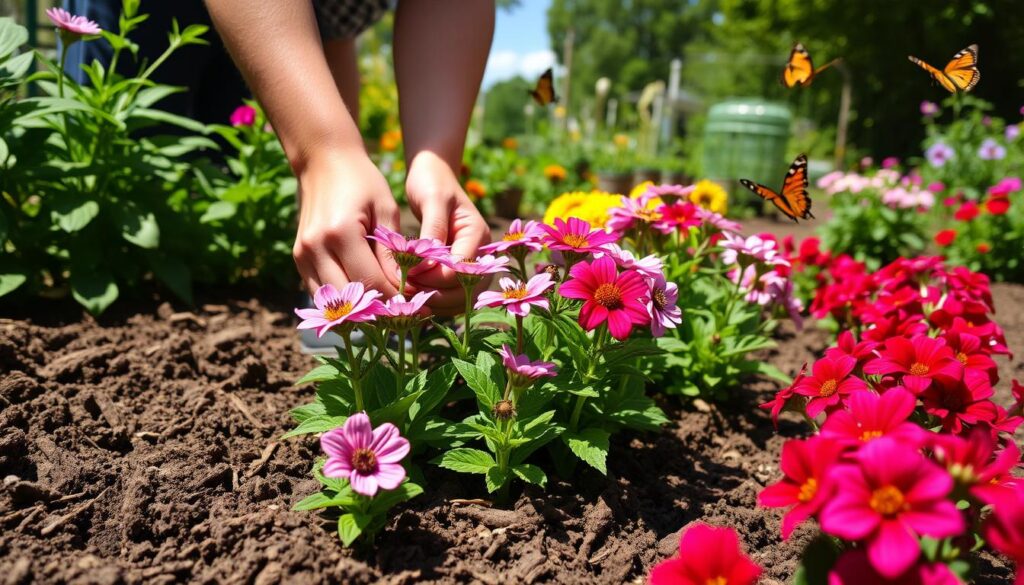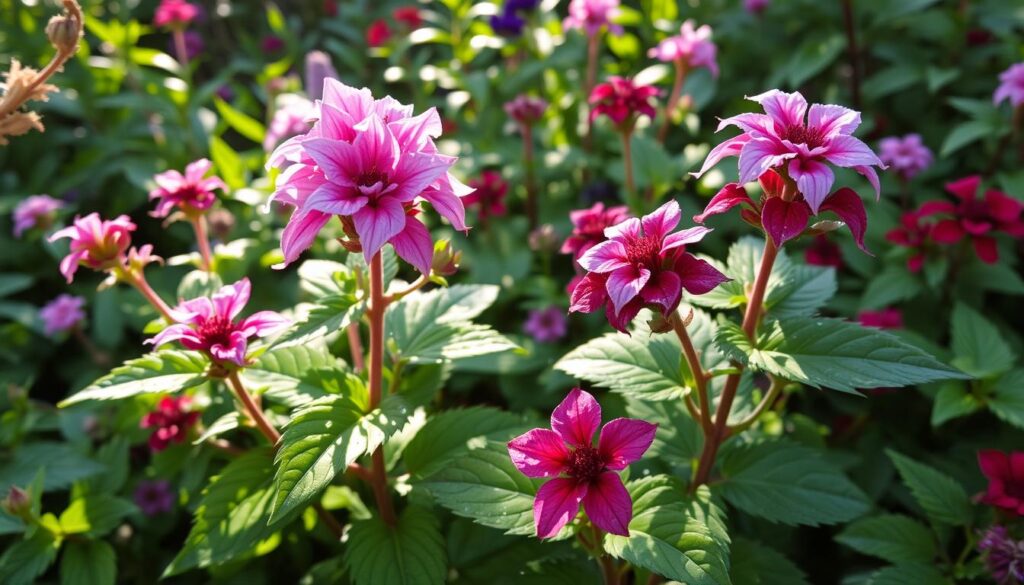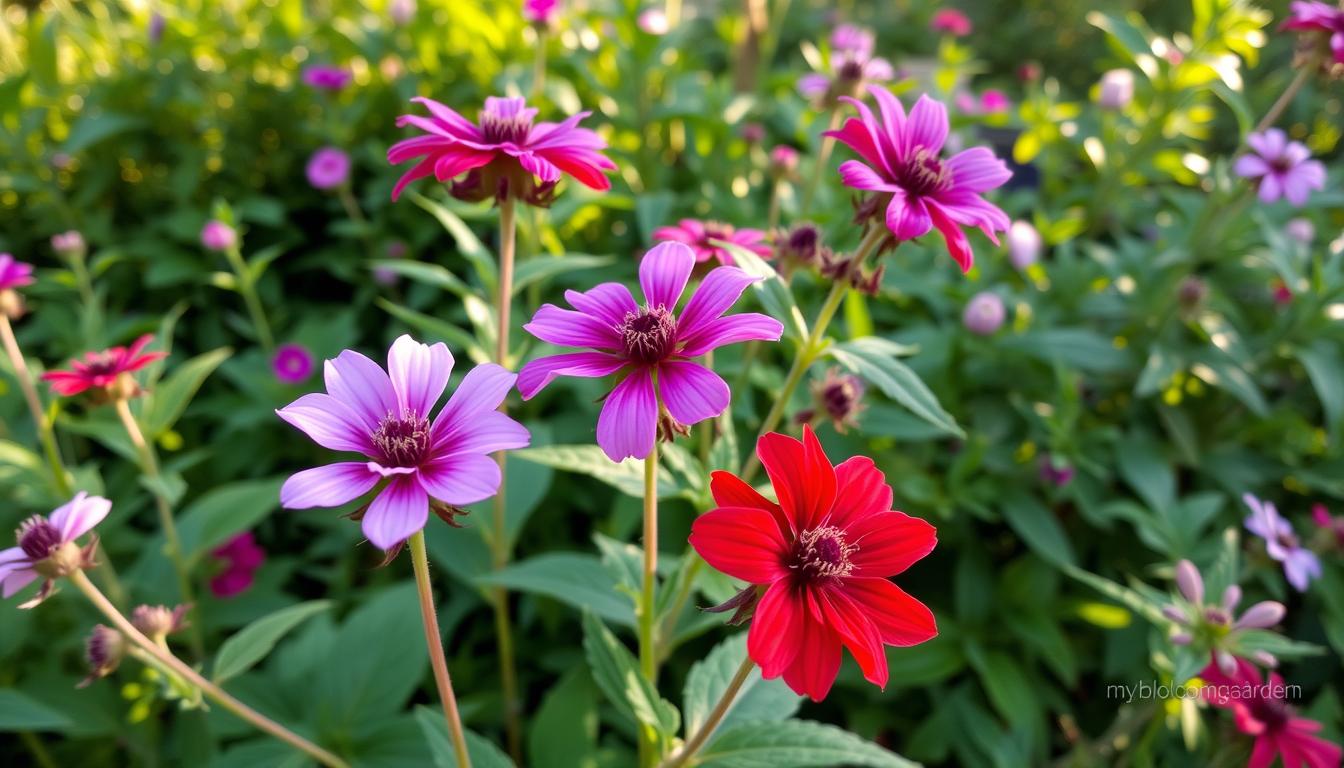As the warm summer breeze gently caresses my face, I’m captivated by the vibrant hues in my garden. The striking blossoms of bee balms stand tall, attracting pollinators and captivating the senses. These resilient perennials have become a true passion of mine, and I’m eager to share the secrets of their cultivation with you.
Bee balms, also known as Monarda, are a beloved addition to any garden. They offer a burst of color that can transform a simple border into a captivating oasis. Whether you’re a seasoned gardener or new to horticulture, this guide will equip you with the knowledge and confidence to grow these enchanting flowers in your own backyard.
Table of Contents
Understanding Bee Balms: A Colorful Garden Essential
Bee balms, also known as Monarda, are fascinating plants from North America. They are known for their bright colors and many uses. Learning about their origins and types can deepen your appreciation for these plants.
Native Origins and Natural Habitat
The bee balm plant, or Monarda, grows in eastern and central North America. It thrives in places like prairies, meadows, and woodland edges. These plants can grow in many soils and conditions, making them great for gardens.
Common Varieties and Their Characteristics
Bee balms come in many shapes, sizes, and colors. This variety makes them a great choice for gardens. Some popular types include:
- Monarda didyma, known for its bright red flowers and strong minty aroma.
- Monarda fistulosa, with its lavender-pink blooms and a more subtle fragrance.
- Monarda ‘Raspberry Wine’, a hybrid with deep-pink to purple flowers and a longer bloom time.
Benefits for Pollinators and Gardens
Bee balms are great for gardens, attracting bees, butterflies, and hummingbirds. Their nectar-rich flowers are a key food source for these creatures. The plants’ scent can also keep pests away. They add beauty and support local ecosystems, making them essential for eco-conscious gardeners.
“Bee balms are not only visually stunning, but they also play a crucial role in supporting the health of our local ecosystems. By incorporating these vibrant plants into your garden, you’ll be providing a valuable resource for pollinators and enhancing the overall biodiversity of your outdoor space.”
Selecting the Perfect Location for Your Bee Balm Plants
Choosing the right spot for your bee balm is key to a vibrant garden. The location you pick affects their growth and your garden’s look.
Bee balm loves lots of sunlight. They need at least six hours of direct sun each day. But they can handle some shade too. Don’t plant them in too much shade, as they might grow tall and not bloom much.
- Think about the soil conditions too. Bee balms do best in well-drained, rich soil that’s slightly acidic, between 6.0 and 7.0 pH.
- Good air circulation is also important. It helps prevent fungal diseases that can harm bee balms.
- When picking where to plant, think about the plants around them. Bee balms are great companion plants for other flowers, herbs, and veggies. Just remember they need space to grow.
“Choosing the right location is the first step towards a thriving bee balm garden.”
By keeping these points in mind, you can make a great spot for your bee balm plants. They’ll add color and attract pollinators to your garden.
Essential Soil Requirements and Preparation
To make your bee balm plants (Monarda) bloom brightly, you need to know about soil. These beautiful perennials love soil that drains well and is full of nutrients. This kind of soil is the best for their growth and flowers.
Soil pH and Composition
Bee balm plants do best in slightly acidic to neutral soil. The ideal pH is between 6.0 to 7.0. The soil should be a mix of loam, sand, and organic matter. This mix gives the plants the nutrients and air they need to grow well.
Drainage Requirements
Bee balm plants need well-draining soil to avoid waterlogged conditions. Make sure the soil drains well to prevent root rot and other problems. This helps the plants grow strong and healthy.
Soil Amendment Tips
- Adding compost or aged manure to the soil boosts its organic matter and nutrients.
- Putting mulch around the plants keeps the soil moist and stops weeds.
- If your soil is heavy or clay-like, mix in sand or perlite. This improves drainage and aeration.
By preparing the soil right, you create a perfect home for your bee balm plants. They will bloom beautifully and add color to your garden.
“Bee balm plants are a true delight in the garden, adding pops of color and attracting a variety of pollinators. Ensuring the right soil conditions is key to their success.”
When and How to Plant Bee Balms
Timing is key when planting bee balm (Monarda) plants or seeds. Spring or fall are the best times. The soil should be moist but not soggy.
For seeds, start them indoors 6-8 weeks before the last frost. Wait until they have their first true leaves. Then, move them outside. Planting seeds directly in the garden in spring works too, but it takes longer for them to bloom.
For divisions or established plants, spring or fall is the best time. Dig a hole that’s twice as wide as the root ball. Place the plant at the same depth as before. Fill with soil, water well, and mulch to keep moisture in.

“Bee balm is a true garden workhorse, adding pops of color and attracting pollinators to your landscape.”
Starting from seed or transplanting established plants requires the right care. With a bit of effort, you’ll soon enjoy their vibrant colors and sweet scent.
Proper Spacing and Growth Patterns
Understanding the height and spread of bee balm plants is key to a thriving garden. Bee balms, or Monarda, come in different sizes. The right spacing and companion planting make your garden look great.
Height Considerations
Bee balm plants can be small, around 12 inches tall, or very tall, up to 4 feet. Choosing the right size for your garden is important. It keeps your garden looking balanced and prevents plants from getting too crowded.
Spread Expectations
The spread of bee balm plants also varies. Some spread only 12-18 inches, while others can grow up to 3 feet wide. Giving plants enough space or mixing them in borders helps control their spread.
Companion Planting Options
- Short bee balm varieties look good with coneflowers, black-eyed Susans, or ornamental grasses.
- Taller bee balm plants make great backdrops with lower-growing plants or annuals.
- Choose plants that bloom at different times for a garden full of color all season.
Knowing how bee balms grow helps you plan a beautiful, bee-friendly garden. It’s a place where these plants can thrive and be enjoyed.
Watering and Moisture Management
Proper watering is key for your bee balm plants to thrive. They love well-drained soil that stays moist. Knowing their water needs helps your plants bloom brightly all season.
To keep bee balms happy, aim for moist but not soggy soil. They need about 1 inch of water weekly, from rain or watering. In hot, dry times, water them more to keep the soil moist.
- Water your bee balms in the morning or evening to reduce evaporation.
- Avoid getting water on the foliage, as this can lead to fungal diseases.
- Mulch around the plants to help retain soil moisture and suppress weeds.
If your bee balm leaves are wilting, they need more water. If they turn yellow or the soil is too wet, you’re watering too much. Watch the soil moisture and adjust your watering.
Follow these tips for bee balm growing and moisture management. Your plants will thrive, adding stunning color to your garden all season.

“Watering is crucial for the health and vitality of bee balm plants. Consistency is key to keeping the soil moist but not waterlogged.”
Seasonal Care and Maintenance Tips
To keep your bee balm plants healthy, follow some seasonal care tips. These simple guidelines will help your bee balm flowers stay vibrant. They will also attract many pollinators to your garden.
Spring Care Guidelines
When the weather gets warmer, your bee balm plants need some extra care. Start by cutting off any dead or damaged leaves. Remove any debris or mulch around the plants. This helps them grow strong and healthy.
You might also want to divide overcrowded bee balm clumps. This will make the plants healthier and encourage more flowers.
Summer Maintenance
In the summer, your bee balm plants will be in full bloom. This attracts many pollinators to your garden. To keep them looking great, regularly remove spent flower heads.
This not only makes the plants look better but also encourages more blooms.
Fall Preparation
As the growing season ends, prepare your bee balm plants for winter. Cut the foliage back to about 6-8 inches above the ground. Then, add a layer of mulch around the base to protect the roots.
This will help your bee balm perennial survive the harsh winter. It will come back strong in the spring.
By following these seasonal care tips, your bee balm plants will stay healthy and blooming. They will add color and attract pollinators to your garden all year.
Managing Common Pests and Diseases
Keeping your bee balm garden healthy means watching out for pests and diseases. Knowing the common problems and taking steps early can help your plants stay strong and colorful.
Combating Powdery Mildew
Powdery mildew is a big problem for bee balm. It looks like a white powder on leaves and stems. Make sure your plants have enough air and don’t overcrowd them. You can also use a baking soda mix or a fungicide to fight it.
Deterring Aphid Infestations
- Aphids are tiny insects that can harm bee balm. To keep them away, attract good bugs like ladybugs and lacewings with other flowers.
- Also, check your plants often and remove aphids by hand or with a mild soap solution.
Preventing Leaf Spot Diseases
Leaf spot diseases can ruin your bee balm’s leaves. Make sure your plants get enough air. If you see signs of disease, use a fungicide right away.
“Proactive care and vigilance are key to maintaining a thriving bee balm garden.”
By quickly dealing with pests and diseases, you can keep your bee balm plants healthy. This way, you’ll enjoy their beautiful flowers for many seasons. Stay alert, and your garden will be a burst of color and life.
Propagation Methods for Bee Balm Success
Expanding your bee balm collection is rewarding. There are several effective ways to do it. Whether you’re experienced or new to growing monarda bee balm seeds and plants, this guide helps.
Division Techniques
Division is an easy way to propagate bee balm. You dig up and split the plant’s roots, making sure each part has roots and leaves. Do this in early spring or late fall, so the plants can grow well before the season starts.
Seed Starting Tips
Starting bee balm seeds indoors is rewarding. Plant them in a mix that drains well and give them bright light. Remember, bee balm seeds take weeks to germinate.
Cutting Propagation
Stem cuttings from healthy bee balm plants work well too. Pick stems without flowers, dip them in rooting hormone, and plant in a mix that drains well. Keep them moist and in the shade until they grow roots, which takes weeks.
These methods help you multiply your bee balm plants. You can share the colors and scents with other gardeners. Try different methods to see what works best for you.
Harvesting and Using Bee Balm Flowers
Bee balm, also known as Monarda, is a versatile and fragrant herb. It offers many uses beyond its stunning garden displays. The vibrant bee balm flowers can be used in cooking and natural remedies.
Harvesting Bee Balm Flowers
To harvest bee balm flowers, wait until they are fully open. Snip the flowers off the plant, leaving a short stem. Avoid cutting the leaves, as they are important for the plant’s health. Harvest in the morning, when the essential oils are most concentrated.
Culinary Uses of Bee Balm Flowers
- Add the vibrant bee balm flowers to salads for a unique flavor.
- Infuse bee balm flowers into teas for their fragrance and taste.
- Use the flowers to make jams, jellies, and syrups, capturing their natural sweetness.
- Experiment with bee balm flowers in baked goods, such as scones or shortbread cookies.
Medicinal and Therapeutic Benefits
Bee balm flowers have been used in traditional medicine for their soothing and healing properties. They can be brewed into a tea to alleviate digestive issues, reduce inflammation, and even provide relief for colds and flu.
“The versatility of bee balm flowers is truly remarkable, allowing gardeners and nature enthusiasts to fully embrace the beauty and benefits of this captivating plant.”
Whether you’re looking to add color to your cooking or seeking natural remedies, the bee balm flowers in your garden offer a wealth of possibilities. Embrace the bounty of this remarkable plant and explore the endless ways to incorporate it into your life.
Conclusion
Bee balms are vibrant perennials that can make any garden come alive. They have captivating blooms and a lovely fragrance. These plants are great for both you and your local pollinators.
By adding bee balm plants to your garden, you create a welcoming space. This space attracts many beneficial insects. Hummingbirds, bees, and butterflies will all visit.
In this guide, you’ve learned how to grow and care for bee balms. You know how to pick the right spot and handle pests and diseases. These plants love well-drained soil and full sun, making them easy to care for.
Follow the tips and techniques shared here. This way, your bee balm plants will thrive. They will bring you seasons of color, fragrance, and attract pollinators.
Start your bee balm gardening journey with excitement. These perennials are versatile and perfect for any garden. They can add color to your flower beds or create a pollinator-friendly oasis.
Enjoy the beauty and benefits of bee balms in your outdoor space. Revel in the vibrant, thriving garden you’ve created.

